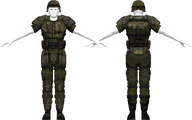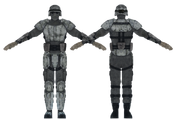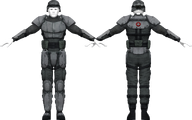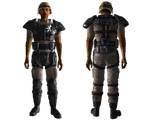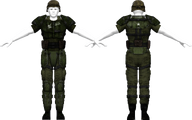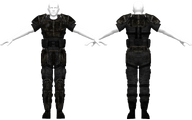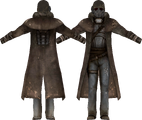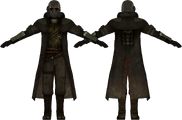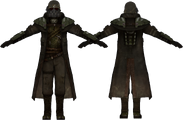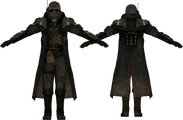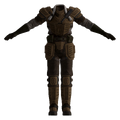Section needed (Fallout 4 isn't mentioned here yet)
This section is required but has not been written yet. You can help Nukapedia by writing it.
|
| This is an overview article, listing content appearing in multiple games. |
Combat armor is among the best forms of protection in the post-War wasteland. Although extremely expensive, the protection value of this armor and its variants is surpassed only by power armor. It was designed to sheath the human body as completely as possible with a high-durability armor.
Background
Construction
First created in 2051, the military-grade combat armor was designed to protect key sections of the human body from ballistic trauma with hard armored plates made from complex polymers and ceramics, with a flexible body suit interwoven with thermal-dissipative membranes and bulletproof material. The earliest models of the combat armor were manufactured as specific plates mounted on combat webbing, although as the technology improved, body-enclosing suits of armor were created and entered active combat duty, though in limited quantities. The armor came with a matte-finish olive drab coloring by default, making it suitable for woodland and/or urban camouflage.
The combination armor layers of a suit of adequately-maintained combat armor grant the wearer significant protection from most types of damage, including laser, plasma, ballistic (bullets, shrapnel), and blast damage - uncommon for personal armor. Furthermore, it does so without the extreme weight inherent in most battle armor systems of the 20th and 21st centuries. In summary, combat armor provides outstanding protection at comparatively low-weight and high-comfort levels.
Pre-War users
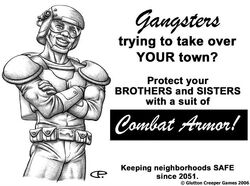
Combat armor ad from Fallout d20
Prior to the Great War, combat armor was nearly exclusively the property of military forces and special police units. Currently-available historical documentation shows users only in the North American continent, but allied nations were likely to possess identical or similar systems. Combat armor was the de facto armor of the United States military, issued to all combat soldiers not in the powered armor units. Additionally, at least one Canadian partisan was caught on camera wearing a suit of combat armor.
Civilian ownership of combat armor was highly restricted. A special permit was required from the Bureau of Alcohol, Drugs, Tobacco, Firearms and Lasers for private ownership of the combat armor (though it was marketed to US citizens without mentioning this fact).
Post-War users
After the war, it became a valuable item, especially as the number of usable suits dwindled in the centuries that followed. Only those who are either very wealthy, very well-connected, very skilled, or simply very lucky own combat armor - and even for those people, finding a suit can be a task.
West Coast
In 2161, combat armor was rare outside large population centers. The Gun Runners that originated in the Hub owned and wore several sets, while a few merchants had a suit available for sale at extremely high costs. The armor was also used by the Hub police. The Brotherhood initiates used a superior variant.
In 2241, the armor became more popular, used by the Vault City guard, New California Republic Rangers, Hubologist guards and even some raiders, as evidence by Bishop's mercenary raider captains and Darion's elite raiders. The selling price was lower, but locating a set of the armor was still difficult. Shops in San Francisco often had a set or two in stock, but usually for $12,000 or more.
In 2281, pre-War combat armor has been largely superseded by post-War designs, especially by larger and most powerful factions. However, some mercenaries and most importantly, the Gun Runners still use combat armor, making it uncommon, but not unseen.
East Coast
In 2277, the combat armor is fairly commonplace in the Capital Wasteland, owing the fact that the National Guard was dispatched hours before the bombs fell. First-generation suits are used by several factions who have also recolored it to fit their profile.
First generation armor variants
Basic combat armor
The basic model of combat armor is essentially a pre-War olive-drab military body suit, worn with combat webbing to which armored plates forming the combat armor are mounted. It offers decent protection (and reliability, as broken plates can be simply swapped for fresh ones), although lacks the coverage later models offer.
The helmet is a standard ballistic assembly, with a back-mounted battery that can be used to power any helmet attachments.
- For other versions in Fallout Shelter, see: sturdy combat armor, heavy combat armor, battle armor, sturdy battle armor and heavy battle armor
US Army combat armor
US Army combat armor is different from standard combat armor in four primary ways, the first of which are aesthetic. The leggings are slightly darker, and have added cargo pouches. There is also a single chevron on either shoulder pad, indicating a rank of Private. Additionally, the US Army combat armor has more damage threshold than normal combat armor or reinforced combat armor, with only slightly less than Mk II reinforced combat armor. It also gives a bonus to the guns and survival skill.
Winterized combat armor
This winterized version was used by the United States during the Anchorage Reclamation campaign in Alaska. The winterized combat armor includes snow goggles,a mask and protective bracers in addition to the other features already present in combat armor.
Winterized medic combat armor
A special winterized version was used by doctors and medics during the Anchorage Reclamation campaign in Alaska. It closely resembles the winterized combat armor, except it doesn't have the mask and black goggles for the helmet, and has a red cross symbol on the back.
Security uniform
A weaker, civilian version of combat armor used by the Tenpenny Tower Security and Rivet City security after the War. The Tenpenny Tower version is very similar to the basic combat armor but with a desert color, while the Rivet City one has a black color and a modified combat helmet resembling a riot helmet.
Talon combat armor
A black-colored variation of the basic combat armor. The suit also bears the Talon Company logo in white on the left breast. There is also a unique version - Lag-Bolt's combat armor.
Reilly's Rangers combat armor
A version of the basic combat armor used by Reilly's Rangers. This version offers superior damage resistance and bears the Reilly's Rangers insignia while retaining the standard olive-drab camouflage with matte finish.
Van Graff combat armor
An improved basic combat armor used by the Van Graff family. It is colored matte-black for "brand recognition purposes", but has no matching black helmet. It closely resembles the Rivet City security uniform.
Sim regen armor
| The following is based on Fallout 3 cut content. |
A version cut from the final version of the Fallout 3 add-on, Operation: Anchorage. It is identical in appearance to standard combat armor.
Second generation (reinforced) armor variants
Reinforced combat armor
In this more advanced and expensive pre-War model, the torso is covered by the primary armor assembly, including a vest enclosing the entire chest and upper abdomen, pauldrons and an armored plate covering the lower abdomen. It is typically worn over a long-sleeved body suit, with proper combat webbing attached by default. The lower body incorporates no hard armor, save for armored boots and kneepads.
The helmet is a ballistic assembly, designed to protect the wearer from projectile and energy weapon impacts, bladed weapons, blunt trauma, and concussion. An integrated polarized visor not only protects the user's eyes from the ordinary battlefield hazards of grit and dust, but also from laser blindness and flying fragments. The helmets also incorporate combination camera/laser rangefinder units built into the helmets' right side, just above the ear. Those suits of combat armor surviving in the wasteland still have the housing for that equipment, but no suit has been documented as having working hardware.
Reinforced combat armor mark II
An improved version of the Reinforced combat armor, designed to replace it, this high tech suit was created as a heavier, more protective armor reserved for use by American shock troops and special forces.
This suit of armor is even more durable than the standard reinforced combat armor, providing modestly greater protection against all forms of damage. Some of its variants are visually identical to the older model, while others feature a modified design.
Brotherhood combat armor
The Brotherhood of Steel has also developed their own improvement on the reinforced combat armor. Called, creatively, Brotherhood armor, this version boasts significantly-improved defensive ratings in all forms of damage. However, this armor did not see widespread use as its holdings were zealously restricted to the ranks of the Brotherhood and those who had been of unique assistance to the Brotherhood. Its distinguishing marks includes pale green/gray coloring of the armor panels, blue trim on the chest armor panels, a light gray body suit, and pronounced riveting on the pauldrons.
Third generation combat armor variants
NCR Veteran Ranger combat armor
A military-grade armor originally used by LAPD riot squads, this combat outfit is typically worn with a matching military helmet with built-in low light optics, a combinaton IR/white light lamp and gas mask.[1] It is traditionally worn with the Desert Rangers' traditional duster (with the NCR Rangers' insignia on the left flap) and a set of rodeo jeans. Its creation was based on the Desert Ranger combat armor for the NCR Veteran Rangers after the merge between the Desert Ranger and the NCR Rangers in 2271.
Desert Ranger combat armor
A military-issue armor from the same manufacturer as the LAPD riot armors, this particular type of combat suit was provided to U.S. Marines operating in China. Boasting a desert camouflage pattern, the armor provides quality protection and is typically worn with a matching military-grade helmet with built-in low light optics, a flashlight and gas mask. Owner data is printed on the collar and includes rank, name, service branch and blood type, to facilitate easy identification of wounded and dead soldiers.
Riot gear
It resembles the NCR Ranger combat armor, but with a black duster and different markings on the chest plate as well as green details on both the duster and the body armor such as a dark green color and pouches located on the side of the duster's sleeves. The helmet also features a different design on the gas mask and a small spike protruding from the tip of it. The helmet also gives the effect "Sneak Sight", which gives the player low visibility sight while in sneak mode. This will toggle from on to off once you exit sneak mode.
Advanced riot gear
The Advanced riot gear appears to be a more heavily armored version of the riot gear. The shoulder pads are bulkier and worn on top of the duster, and the chest plate seems to be slightly greener. It appears to have much thicker armor plates on the forearms. It also has a faded 11th Armored Cavalry Regiment emblem on the helmet. The suit itself looks a lot thicker and the duster looks darker along with a cleaner appearance. The eyes of the helmet glow red at night, much like the NCR Ranger combat armor during the Fallout: New Vegas intro. The helmet's air-filtering system seems to be more advanced, and there is a Flashlight on the side of the helmet, however, this cannot be used by the player or any other character. The suit also weighs 5 pounds less than standard riot gear, NCR Ranger combat armor, or even Desert Ranger combat armor.
Elite riot gear
A unique version of the riot gear with different shoulder plates from advanced riot gear, and a larger amount of pouches and equipment on the torso plate and duster. It also lacks the faded 11th Infantry emblem on the helmet and has the addition of green tubes on its enhanced gas filter as well as an antenna connected to the flashlight on the right side of the helmet. There is also a canteen attached to the belt and a bandolier that spans across the chest plate. It provides a high level of protection for its weight and the only medium armor with a higher DT is the Gannon family Tesla armor.
Other types of combat armor
The armors listed below are similar in function or design, but otherwise unrelated to the American modular combat armor.
NCR Ranger patrol armor
The NCR Ranger patrol armor is a combat armor worn by the NCR Rangers in 2281. Each model is made by hand in the NCR and features full body armor, a knife sheath on the left chest plate, a camelback style hydration pouch in the back and the Ranger insignia on both pauldrons.
Urban combat armor
| The following is based on information from Fallout: Brotherhood of Steel. |
A recovery combat armor, crafted with Kevlar and metal plating put on a leather armor, created after the Great War and only seen in Texas.

